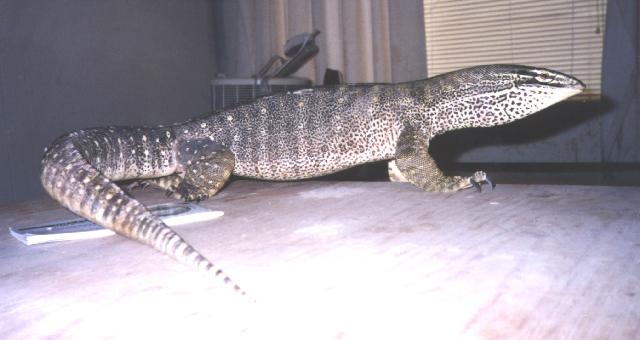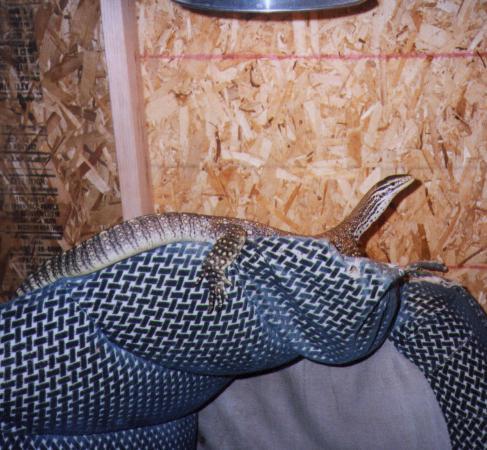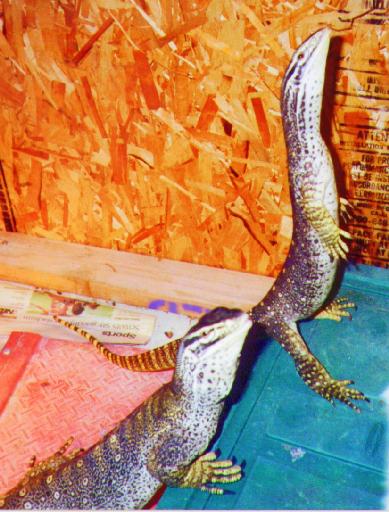
Hall puts on a threat display
Here is the story of my various argus monitors, my trials and tribulations with these amazing animals, my successes and tragedies. Over the years that I have kept argus monitors, I hope that I have learned a few things, and that past mistakes will not be repeated. I also hope that argus monitors will always be a part of my life.

Hall puts on a threat display
Argus monitors are known scientifically as Varanus panoptes. They hail from the tropical island of New Guinea and the exotic continent of Australia. There they live out their lives chasing down smaller lizards, digging up bugs and small mammals, raiding bird's nests, scavenging roadkill, chasing each other off their territory, excavating burrows, climbing trees, wriggling under rocks, going for a swim, avoiding hungry dingos, larger monitors, eagles, and the native humans, or cruising for mates so that they can replace those that were less adept at avoiding the dingos, larger monitors, eagles, and humans.
These are quite large lizards, acting as one of the major mid-sized predators in the region where they live. In appearance, they are simultaneously slender and powerfully built, with thick ropes of muscle running down their neck, torso, and tails. Their limbs are massive and equipped with sharp claws for digging, climbing, and ripping apart prey too large to swallow whole. Their head is a sharp triangle fitted with rows of knife-like teeth and a long forked tongue for probing scents from the ground and air. They are marked brown over a cream underside, prominantly patterned with yellow and black spots aranged in bands.

Oz basks on her couch.
Argus monitors are amazingly active, displaying a curiosity and restlessness more apropriate to a mammal or bird than a typical reptile. When scampering about, they hold their body well off the ground, investigating their surroundings with quick, rapid movements and flicks of the tongue. When stopped, they will often stand upright on their hind legs, using their tail as a brace, to get a better look around. Their athleticism is amazing, and the antics they will go through to snatch a choice morsel or get to some unexplored location have left me amazed on more than one occasion. They can jump to snatch things from the air or grab a convenient foothold, chimney up crevices, climb smooth poles with the pressure of their legs on either side, dig through hard packed soil, wriggle through small holes, and much more. They have faster reflexes than most humans, and more strength than most animals their size. Their eyesight is good, and their sense of smell nothing short of phenomenal. Anything they sense is likely to be checked out to see if it is edible or otherwise useable. Their intelligence is clearly higher than that of typical reptiles. Arguses can learn quickly, especially where food is involved.
Possibly related to this intelligence, argus monitors have social abilities above that of most other reptiles. They can recognize others as individuals, and quickly form oppinions on who they can and cannot trust. They seem to form pair bonds, with females accepting a known male and mating only with that male. The male, on the other hand, is quite promiscuous, but although much larger, he does not attack and eat "his" females. The females can also recognize their own nests. They will happily eat the eggs of other females, but not their own. They even defend their nests from other monitors and sometimes even much larger predators for a short time (at least) after laying eggs. As hatchlings, all the monitors from a single clutch will hang out together in the same tree or same general area. The social bonds they form with their siblings are said to last for life, those siblings who survive are trusted as adults. In my experience, males rarely get along with strange males, and females rarely get along with other females. Females are often scared of strange males, but if the male does not try to kill the female and she has not yet bonded with another male, she may accept that male as a mate. If she has already bonded with another male, she may act agressively towards the new male and try to drive him off. Social situations are always complex, and there will be more variety and confusion that these general rules I list here seem to indicate, but these are some of the things that I have observed with my monitors.

Photo by Brie Earnst
A closeup of Dash.
Arguses are extremely voraceous. Insatiable eating machines, they attack potential prey with an amazing violence and enthusiasm. Nearly anything vaguely meat-like is liable to be interpereted as food by these animals - insects, lizards, snakes (even venomous ones), small mammals, eggs, carrion, they'll eat it all. Prey that is alive and struggling is killed by biting and shaking it violently. The vigorous thrashing of the argus's body often lifts it clear off the ground. This not only dashes struggling prey against the ground and rocks, but yanks the razor-sharp teeth through skin, meat, and tendon. Most prey they will swallow whole, just gulping down the smaller stuff with a few snaps, or spending some time mashing and shoving larger items down their gullet. Anything too big to fit down in one piece is ripped apart, usually with the claws. If they are completely bloated, they will spend a while laying in the heat to digest their meal. More likely than not, however, they are up and about again immediatly looking for more.
A wild argus monitor will seek to avoid confrontations with people or other potential predators. At the first sight of trouble, they run for cover. An argus can outdistance a person for a stretch of several hundred meters. This is usually far enough to dive into a burrow or body of water, or climb up a tree above the reach of most adversaries. When startled in the wild, they have a disturbing tendancy to climb up any tall nearby object in their attempt to escape, disturbing because they sometimes climb right up people who just happen to be standing around minding their own business. If they cannot reach cover in time to avoid trouble, they confront it. They take up a threat posture, rearing up on their hind legs with their body held at a 45 degree angle, arching their neck, distending their throat, and hissing loudly. If trouble gets to close, they may lash out with their tail to get it to keep its distance. If they are really terrified, they will gape, and their tongue will hang way out of their mouths while they lunge at their agressor. If grabbed, they will take the opportunity to bite, claw, and deficate on their assailant while squirming and struggling to escape. Given their strength and the sharpness of their teeth, there are not many creatures that are willing to take on one of these lizards.
Argus monitors are fairly high strung animals. Some of them can loose their fear of human beings, but they will always be nervous and prone to startle. Also, even when they have accepted that you are not going to hurt them, they will still be active and squirmy when held. None of mine are content to just sit and hang out, they will want to climb all over you, dig up your hair, excavate your nostrils, forage in your pant-sleeves, stick their nose in your ear openings, make flying leaps for inviting looking perches from your shoulders, and so on. They may not be the tamest monitors, but the same hyperactivity that makes them so high strung and excitable is also what makes their antics so fun to watch. Among my animals, the females seem more high strung than the males, but I have too small of a sample size to say if this is universal among argus monitors or not. Like all monitors, however, the hatchlings and juveniles are extremely squirmy, paranoid, jittery, and edgy. These youngsters are pretty much untameable. They mellow out as they mature, though. By about nine months of age, a well fed argus monitor will be entering sexual maturity and will start to calm down a bit. By two years, it will be considerably more relaxed than that tiny baby you started with.

Argus monitors are known for their frequent "tripoding",
or standing on their hind legs while using their tail as a brace.
Here, Oz poses for the camera in a tripod pose while Merrimac rests nearby.
Click here for
more photos of tripoding monitors.